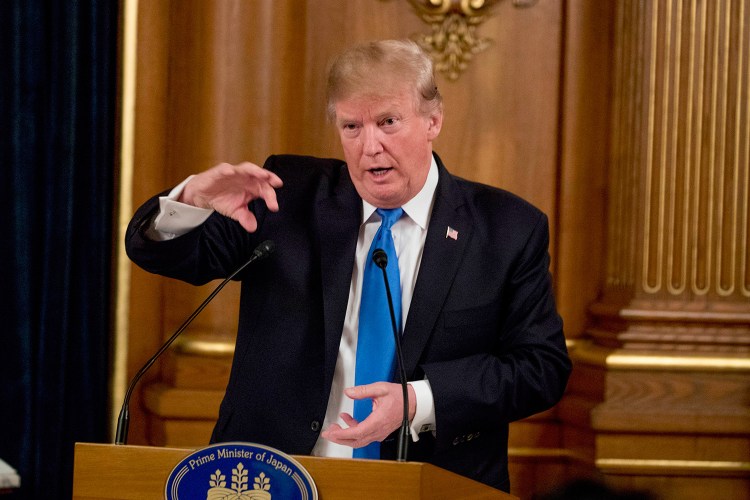TOKYO — President Trump struck a hard line against North Korea’s nuclear weapons program Monday and urged Japan to do the same as he closed out two days of talks, dinner and golf diplomacy with ally Japan.
The president refused to rule out eventual military action against the North and exhorted dictator Kim Jong Un to stop weapons testing, calling the recent launches of missiles over Japanese territory “a threat to the civilized world and international peace and stability.”
“We will not stand for that,” Trump said at news conference with Japanese Prime Minister Shinzo Abe. “The era of strategic patience is over. Some people say my rhetoric is very strong but look what has happened with very weak rhetoric in the last 25 years.”
The president did not deny reports he was frustrated that Japan did not shoot down a ballistic missile North Korea recently fired over its territory. Trump instead declared that Abe “will shoot ’em out of the sky when he completes the purchase of lots of additional military equipment from the United States.”
Trump said Abe had agreed to purchase “massive amounts of military equipment, as he should,” arguing the U.S. makes the “best military equipment, by far.”
Japan’s constitution was revised after World War II to include a clause renouncing war and the country spends only about 1 percent of its GDP on defense. Abe has slowly tried to remove some of the pacifist constraints and is already seeking money to purchase upgraded SM3 interceptors with greater accuracy and range, as well as other advanced missile defense systems.
Under its constitution, Japan can shoot down a missile only when it is aimed at the country or if debris is falling on its territory. But some hawkish members of Abe’s Liberal Democratic Party say that it may be possible to shoot down a missile headed toward Guam if it causes an existential threat to the U.S. as Japan’s ally. Experts say that is questionable.
As part of his Asia tour, Trump will visit South Korea, where he will forgo the customary trip to the demilitarized zone separating the North and the South – a pilgrimage made by every U.S. president except one since Ronald Reagan as a demonstration of solidarity with the South. Instead, Trump planned to visit Camp Humphreys, a military base about 40 miles south of Seoul.
Trump and South Korea’s liberal President Moon Jae-in agree on the need to pressure the North with sanctions and other deterrence measures. But Trump has warned of unleashing “fire and fury,” while Moon favors dialogue as the best strategy for defusing the nuclear tension and vehemently opposes a potential military clash that could cause enormous casualties in South Korea.
Trump backed up his strong words about North Korea by sending a budget request to Capitol Hill on Monday for $4 billion to support “additional efforts to detect, defeat, and defend against any North Korean use of ballistic missiles against the United States, its deployed forces, allies, or partners.”
And as he departed for South Korea, he tweeted that Moon is “a fine gentleman,” adding, “We will figure it all out!”
On a personal level, Trump and Moon have not developed the same close rapport as Trump has with Abe or even China’s Xi Jinping. Part of Moon’s mission during the visit will likely be to strengthen his personal ties with Trump, said Michael O’Hanlon, a senior fellow in foreign policy at the Brookings Institution.
Trump will spend Tuesday in meetings with Moon. Trade also is expected to be a major topic of discussion: Trump has considered pulling out of the United States-Korea Free Trade Agreement, also known as KORUS, blaming it for the U.S.-South Korea trade deficit.
Send questions/comments to the editors.


